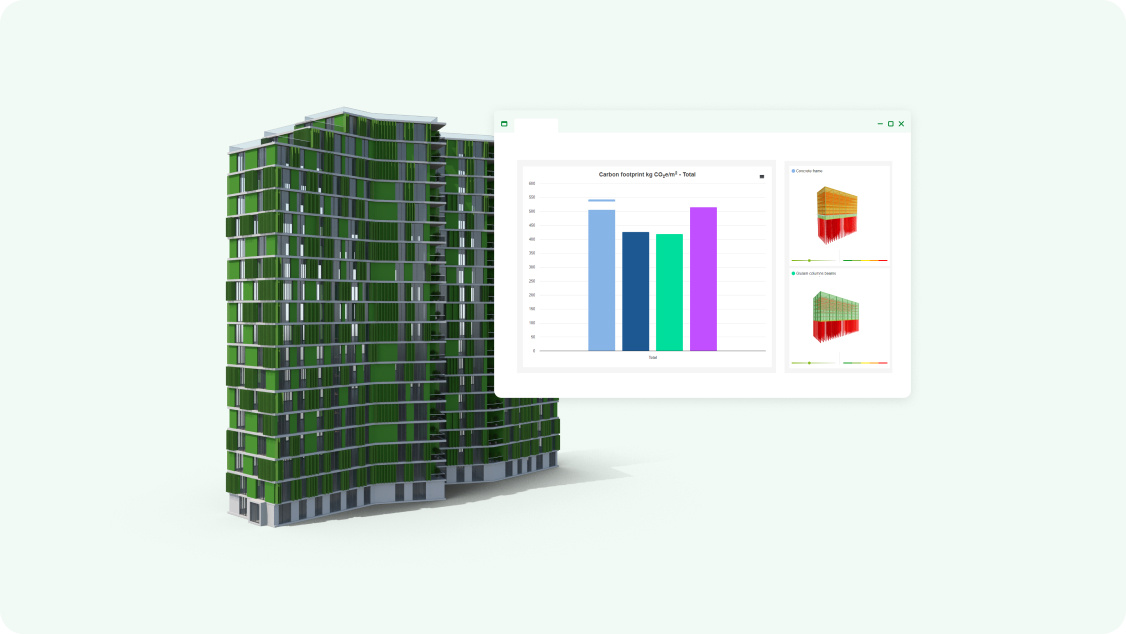article
Carbon Designer 3D for business success & early carbon optimization worldwide

Carbon Designer 3D (CD3D), developed by One Click LCA, is a carbon optimization tool offering several business benefits. It allows you to perform life-cycle assessments (LCA) early in the design process, helping you make flexible decisions to meet decarbonization goals. Explore CD3D and learn how its regional customization can meet your specific needs.
What are the business benefits of Carbon Designer 3D?
CD3D facilitates early LCA during design, enabling flexible decision-making to achieve decarbonization targets. This tool produces a detailed bill of materials for early cost estimation and addresses informational gaps in models. CD3D streamlines the design process, identifies carbon hotspots quickly, and provides early feedback on potential savings. Optimizing embodied carbon impacts using CD3D helps set targets and win more projects. Begin your analysis by selecting the building type and size, adjusting materials and structural elements, and comparing designs to choose the most carbon-efficient option.
What insights does Carbon Designer 3D provide?
CD3D offers insightful analyses, presenting a breakdown of the bill of materials, carbon impact reductions, comparisons, and identification of hotspots. Results are accessible by building part or component, and integrating local classification systems. Insights extend to material-level assessments, enabling informed decision-making in architectural design. This tool facilitates the optimization of carbon footprints and maximizes flexibility in project stages, making it valuable for sustainable construction practices.
Optimizing carbon early with Carbon Designer 3D
The window for impactful carbon reduction narrows as projects progress. The key to staying ahead? Early carbon optimization. CD3D enables up to 50% emission reductions effortlessly. Learn about CD3D with product experts Kostas and Myriam.
Understanding how Carbon Designer 3D works
CD3D operates through a systematic process that involves data input, analysis, customization, compliance, and continuous improvement.- Data input: Users input project-specific data, including building geometry, materials, and specifications, through an intuitive interface.
- Analysis and calculation: The tool performs complex calculations to assess the environmental impact of the construction project, considering factors such as carbon footprint, and resource use throughout the building's life cycle.
- Customization and optimization: Users can customize and optimize building designs to minimize environmental impact by exploring different scenarios, materials, and design options.
- Compliance and reporting: Carbon Designer 3D ensures compliance with local building regulations and environmental standards and generates comprehensive reports and documentation.
- Continuous improvement: The tool is continually updated to incorporate the latest data and methodologies in sustainable construction, ensuring accuracy and reliability.
How is Carbon Designer 3D customized to meet regional requirements?
CD3D is customized to meet regional requirements, ensuring compliance with local building codes and environmental standards. The process begins with thorough research into local construction trends and preferences. Working with local experts and forming partnerships with regional entities are key, enabling a deep understanding of specific regional needs.
For example, countries such as Finland, France, Germany, Hungary, and Ireland benefit from unique collaborations in Europe. These collaborations include partnerships with local industry bodies like RTT and Finnish Wooden industry, which informs the Finnish reference building, and similar collaborations in France and Ireland. Such partnerships ensure that models deeply reflect local construction practices and standards.
Moreover, CD3D incorporates specific environmental profiles tailored to each region. For instance, CO2data.fi/SYKE data is used for the Finnish reference building, while industry-standard databases like Okobau.dat are utilized for Germany. In cases where specific data is lacking, One Click LCA and local generic data are prioritized, ensuring a robust foundation for modeling.
Expansion beyond Europe further highlights the tool's adaptability, with coverage extending to the United States, Canada, Australia, New Zealand, Japan, and the Middle East/North Africa. Partnerships with Sumitomo for the Japanese reference building and alignment with regional green building guides such as Green Star Australia and Green Star New Zealand demonstrate the tool's flexibility in catering to diverse regional requirements.
CD3D is continually evolving to accommodate changing regulations and emerging markets. The development of the Danish region, aligned with BR 18 regulations, demonstrates this commitment. Collaboration with local experts remains central to this process, ensuring that the tool remains at the forefront of regional customization in the construction industry.
What if the required variation is missing?
If a required variation is missing, users can create a custom private template with the necessary construction adaptations for reuse in CD3D across their company account. Additionally, users can report any other requests to One Click LCA’s customer success team, who will review them promptly.
CD3D's customization for regional requirements encompasses a multifaceted approach, including research, collaboration, and partnership. By prioritizing local needs and standards, the tool ensures accuracy and relevance across diverse geographical contexts, facilitating sustainable construction practices worldwide.

